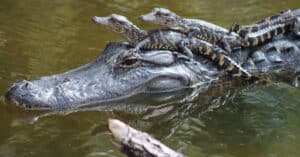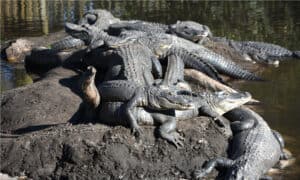Discover the Most Alligator Infested Lakes in Florida
An 11-foot alligator caused a traffic jam just NE of Orlando on April 27, 2022. Cars backed up as the alligator made its way across State Road 417. The Seminole County Sheriff’s Office thought the gator probably came from Lake Jesup, which has a reputation as being an alligator infested lake.
However, that begs the question, what is it the most alligator infested lake in Florida? What other lakes have massive 11-foot alligators? Is there a lake near you that is alligator infested? Let’s find out!
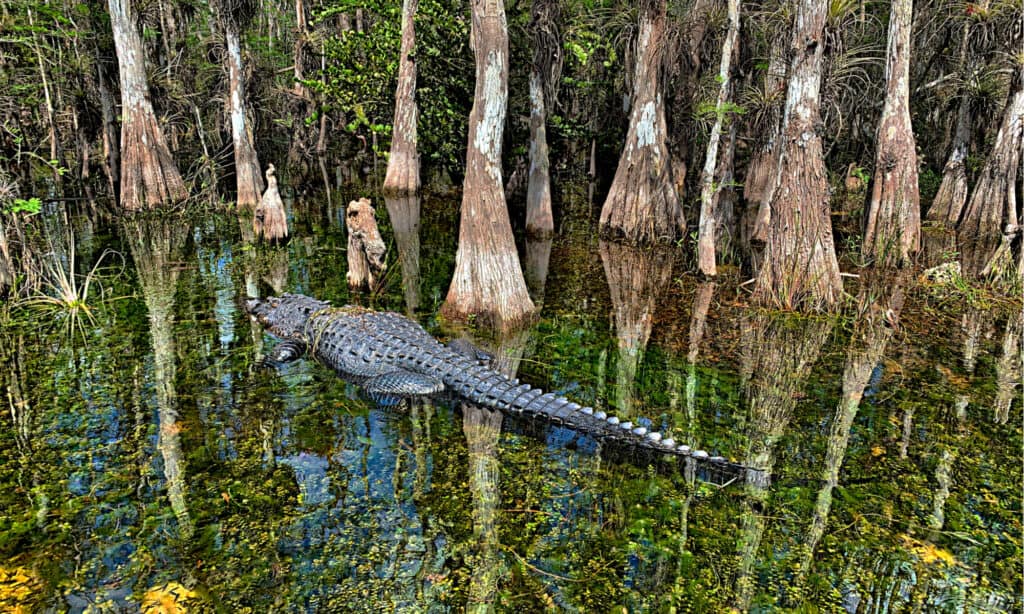
jaimie tuchman/Shutterstock.com
Who counts alligators?
Every year the Florida Fish and Wildlife Conservation Commission works with scientists and biologists to count the number of alligators in the state. The annual alligator census is taken at 50 different sites throughout the state. The numbers are used for a variety of purposes, first to see how the once American Alligator population is doing. 40 years ago the alligators were hunted to the point of being endangered. It is a huge success story that there are now more than 1.3 million alligators in Florida!
Today, the state issues a number of alligator hunting permits to keep their numbers in check. The data from the annual census is used to determine how many permits to issue each year.
How do you count alligators?

Alexey Stiop/Shutterstock.com
Alligators are counted at night. Sound like a scary job? It is! Scientists go out in airboats at night and count the red-glowing eyes of the alligators. They use the distance between the eyes to estimate size. Any alligator over 9 feet long is considered a “bull” alligator. Adult male alligators can get to be 14 feet long and weigh around 1,000 pounds. Remember that counts are not exact and some sources vary from year to year. An Orlando News Station posted a map of the lakes in Florida with the alligator counts. Check out this interactive map of alligator counts, including the number of Bull Alligators. Our list includes the lakes that have more than 100 alligators in this recent count.
What are the most alligator infested lakes in Florida?
The following lakes ranked highest in recent alligator counts. Remember that these are exact counts of alligators and total population estimates are higher. For example, estimates of Lake Okeechobee alligator populations stretch as high as about 30,000 alligators while estimates for Lake Jessup’s population reach 13,000.
It’s also worth noting this list is a total count for alligators in different lakes. Lake Jessup’s alligator count is especially notable for how small it is. The lake has just 25 square miles of surface area, yet it contains thousands of alligators. It’s estimated to be among the densest concentration of alligators for a large lake in America, although Lake Okeechobee has more alligators thanks to its massive size (730 square miles).
#5 Lake Kissimmee 2,065, south-central, Osceola County

iStock.com/Juliana Vilas Boas
If you want to try to see an alligator for yourself you should visit Lake Kissimmee State Park. Remember to always keep your distance from wildlife. It is recommended to stay at least 60 feet away from alligators. Use the zoom feature on your camera to catch the best photos. Do not risk getting too close to an alligator. They can react quickly and attack with little warning if you get too close.
#4 Lake Jesup 2,414, central, Seminole County
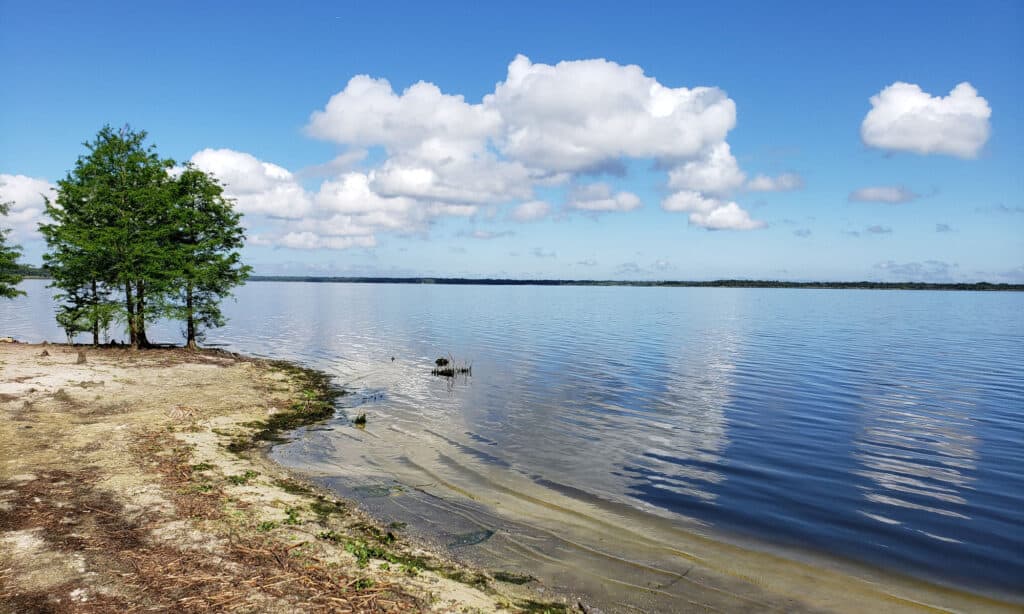
Thomas Decot/Shutterstock.com
Some estimates of alligators in Lake Jesup are as high as 13,000, so this is definitely one of the most alligator infested lakes in Florida. It is a 16,000-acre freshwater lake along the St. John’s River. Some of the locals joke about not being able to skip a rock in the lake without hitting an alligator in the head!
#3 Lake George 2,660, eastern, Volusia County
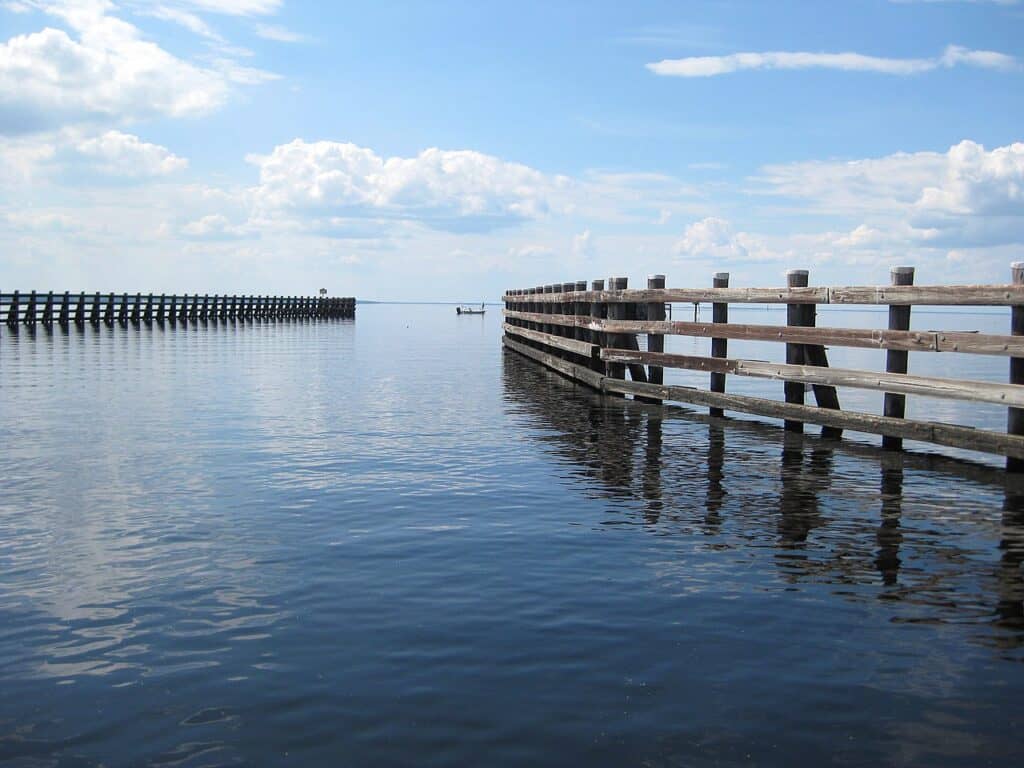
TampAGS, for AGS Media / Creative Commons – License
Lake George is a shallow lake on the St. John’s River, considered the second largest lake next to Lake Okeechobee. Alligators thrive in this lake and along the banks of the river. During the cooler winter months, you may see alligators basking in the sun along the shoreline. Because they are cold-blooded reptiles they need to regulate their temperature by adjusting to the environment.
#2 Orange Lake 2732, central, Alachua County

Thierry Eidenweil/Shutterstock.com
Orange Lake is a 19.61 square mile lake (12,550 acres), the largest lake in north-central Florida. If you are an angler you will know that Orange Lake is a good place to catch Bluegill, crappie, sunfish, and largemouth bass. It is right next to Lake Lochloosa which has a recent count of 338 alligators. It is likely that males travel between the two lakes looking for mates during the mating season.
#1 Lake Okeechobee 9,308, south-central, Palm Beach, Martin, Glades County
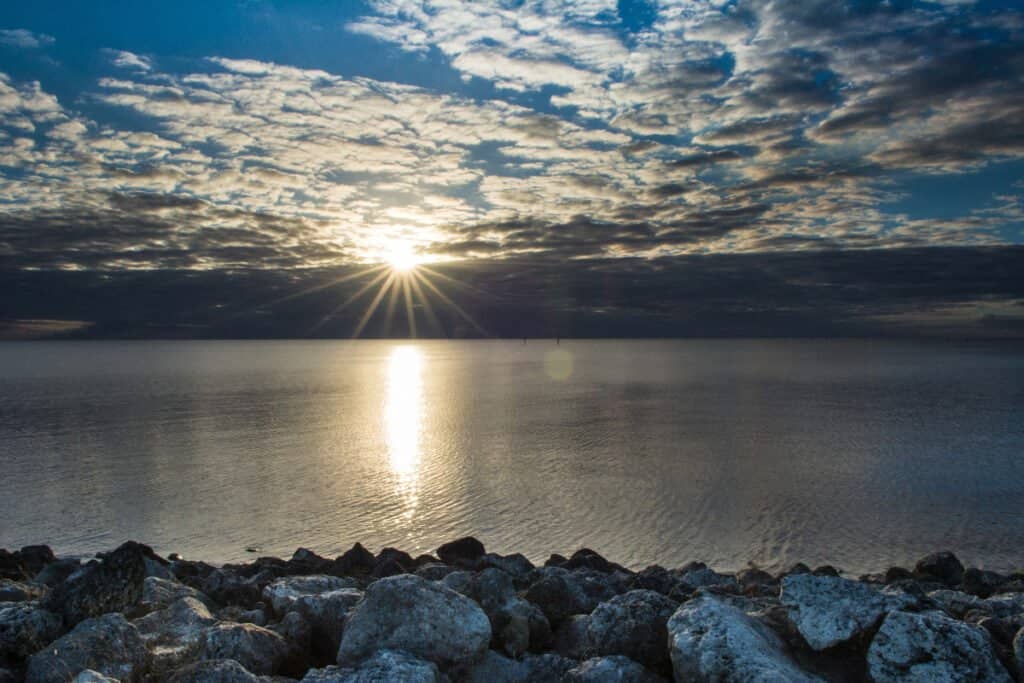
Allison Michael/Shutterstock.com
Lake Okeechobee is the largest lake in Florida. It has a surface area of 730 square miles. Biologists performing the alligator census break the count into different regions of the lake due to the large size. This lake is not only home to the most alligators it has more than 40 native fish species and a variety of birds like egrets, herons, and ibises.
List of Alligator Infested Lakes in Florida
Here’s a list of alligators per lake from the recent count. Remember that their actual populations are likely much larger, this is an actual count of alligators that were spotted!

Robert Gregory Griffeth/Shutterstock.com
- Lake Okeechobee 9,308, south-central, Palm Beach, Martin, Glades County
- Orange Lake 2732, central, Alachua County
- Lake George 2,660, eastern, Volusia County
- Lake Jesup 2,414 central, Seminole County
- Kissimmee 2,065, south-central, Osceola County
- Lake Istokpoga 1,321 south-central, Highland County
- Lake Hatchineha 1,287, central, Polk County
- Kenansville Lake 1,188, southeast
- Lake Rousseau 708, western, Levy County
- Newnan’s Lake 657, central, Alachua County
- Lake Apopka 634, central, Orange County
- Lake Panasoffkee 576, western, Sumter County
- Hancock 559, central, Polk County
- Lake Griffin 534, central, Lake County
- Blue Cypress Lake 499, southeast
- Lake Miccosukee 472, northwest, Jefferson County
- Lochloosa Lake 338, central, Alachua County
- Lake Pierce 314, central, Polk County
- Marion 275, southeast, Osceola County
- Lake Seminole 238, western coast, Pinellas County
- Crescent Lake 214, eastern, Putnam County
- Lake Weohyakapka 195, central, Polk County
- Lake Arbuckle 168, central, Polk County
- Dexter 166, central, Polk County
- Lake Lamonia 144, northwest, Leon County
- Lake Monroe 138, eastern, Volusia County
- Johns Lake 124 central, Orange County
- Lake Wimico 113, northwest, Gulf County
- Lake Hicpochee 109, south-central, Glades County
- Honorable Mention: Alligator Lake 47, central, Osceola County: Although Alligator Lake did not have more than 100 alligators in the recent count; they have to be mentioned for their namesake alone. It is a semi-rural lake so it is not as touristy as GatorWorld for sure. People live on Alligator Lake! I am not a realtor, but that would be a hard sell for me. You could book a room at the Lakeside Inn and Café in St. Cloud, Florida if you feel like spending some time in an alligator infested lake in Florida!
FAQs (Frequently Asked Questions)
What was the largest alligator ever found in Florida?
In 2020 a 13 foot alligator in Florida was measured at 1,0008 pounds. The largest Florida alligator in terms of length is reported to be 17 feet and 5 inches long.
More from A-Z Animals
An 11-foot alligator caused a traffic jam just NE of Orlando on April 27, 2022. Cars backed up as the alligator made its way across State Road 417. The Seminole County Sheriff’s Office thought the gator probably came from Lake Jesup, which has a reputation as being an alligator infested lake.
However, that begs the question, what is it the most alligator infested lake in Florida? What other lakes have massive 11-foot alligators? Is there a lake near you that is alligator infested? Let’s find out!

jaimie tuchman/Shutterstock.com
Who counts alligators?
Every year the Florida Fish and Wildlife Conservation Commission works with scientists and biologists to count the number of alligators in the state. The annual alligator census is taken at 50 different sites throughout the state. The numbers are used for a variety of purposes, first to see how the once American Alligator population is doing. 40 years ago the alligators were hunted to the point of being endangered. It is a huge success story that there are now more than 1.3 million alligators in Florida!
Today, the state issues a number of alligator hunting permits to keep their numbers in check. The data from the annual census is used to determine how many permits to issue each year.
How do you count alligators?

Alexey Stiop/Shutterstock.com
Alligators are counted at night. Sound like a scary job? It is! Scientists go out in airboats at night and count the red-glowing eyes of the alligators. They use the distance between the eyes to estimate size. Any alligator over 9 feet long is considered a “bull” alligator. Adult male alligators can get to be 14 feet long and weigh around 1,000 pounds. Remember that counts are not exact and some sources vary from year to year. An Orlando News Station posted a map of the lakes in Florida with the alligator counts. Check out this interactive map of alligator counts, including the number of Bull Alligators. Our list includes the lakes that have more than 100 alligators in this recent count.
What are the most alligator infested lakes in Florida?
The following lakes ranked highest in recent alligator counts. Remember that these are exact counts of alligators and total population estimates are higher. For example, estimates of Lake Okeechobee alligator populations stretch as high as about 30,000 alligators while estimates for Lake Jessup’s population reach 13,000.
It’s also worth noting this list is a total count for alligators in different lakes. Lake Jessup’s alligator count is especially notable for how small it is. The lake has just 25 square miles of surface area, yet it contains thousands of alligators. It’s estimated to be among the densest concentration of alligators for a large lake in America, although Lake Okeechobee has more alligators thanks to its massive size (730 square miles).
#5 Lake Kissimmee 2,065, south-central, Osceola County

iStock.com/Juliana Vilas Boas
If you want to try to see an alligator for yourself you should visit Lake Kissimmee State Park. Remember to always keep your distance from wildlife. It is recommended to stay at least 60 feet away from alligators. Use the zoom feature on your camera to catch the best photos. Do not risk getting too close to an alligator. They can react quickly and attack with little warning if you get too close.
#4 Lake Jesup 2,414, central, Seminole County

Thomas Decot/Shutterstock.com
Some estimates of alligators in Lake Jesup are as high as 13,000, so this is definitely one of the most alligator infested lakes in Florida. It is a 16,000-acre freshwater lake along the St. John’s River. Some of the locals joke about not being able to skip a rock in the lake without hitting an alligator in the head!
#3 Lake George 2,660, eastern, Volusia County

TampAGS, for AGS Media / Creative Commons – License
Lake George is a shallow lake on the St. John’s River, considered the second largest lake next to Lake Okeechobee. Alligators thrive in this lake and along the banks of the river. During the cooler winter months, you may see alligators basking in the sun along the shoreline. Because they are cold-blooded reptiles they need to regulate their temperature by adjusting to the environment.
#2 Orange Lake 2732, central, Alachua County

Thierry Eidenweil/Shutterstock.com
Orange Lake is a 19.61 square mile lake (12,550 acres), the largest lake in north-central Florida. If you are an angler you will know that Orange Lake is a good place to catch Bluegill, crappie, sunfish, and largemouth bass. It is right next to Lake Lochloosa which has a recent count of 338 alligators. It is likely that males travel between the two lakes looking for mates during the mating season.
#1 Lake Okeechobee 9,308, south-central, Palm Beach, Martin, Glades County

Allison Michael/Shutterstock.com
Lake Okeechobee is the largest lake in Florida. It has a surface area of 730 square miles. Biologists performing the alligator census break the count into different regions of the lake due to the large size. This lake is not only home to the most alligators it has more than 40 native fish species and a variety of birds like egrets, herons, and ibises.
List of Alligator Infested Lakes in Florida
Here’s a list of alligators per lake from the recent count. Remember that their actual populations are likely much larger, this is an actual count of alligators that were spotted!

Robert Gregory Griffeth/Shutterstock.com
- Lake Okeechobee 9,308, south-central, Palm Beach, Martin, Glades County
- Orange Lake 2732, central, Alachua County
- Lake George 2,660, eastern, Volusia County
- Lake Jesup 2,414 central, Seminole County
- Kissimmee 2,065, south-central, Osceola County
- Lake Istokpoga 1,321 south-central, Highland County
- Lake Hatchineha 1,287, central, Polk County
- Kenansville Lake 1,188, southeast
- Lake Rousseau 708, western, Levy County
- Newnan’s Lake 657, central, Alachua County
- Lake Apopka 634, central, Orange County
- Lake Panasoffkee 576, western, Sumter County
- Hancock 559, central, Polk County
- Lake Griffin 534, central, Lake County
- Blue Cypress Lake 499, southeast
- Lake Miccosukee 472, northwest, Jefferson County
- Lochloosa Lake 338, central, Alachua County
- Lake Pierce 314, central, Polk County
- Marion 275, southeast, Osceola County
- Lake Seminole 238, western coast, Pinellas County
- Crescent Lake 214, eastern, Putnam County
- Lake Weohyakapka 195, central, Polk County
- Lake Arbuckle 168, central, Polk County
- Dexter 166, central, Polk County
- Lake Lamonia 144, northwest, Leon County
- Lake Monroe 138, eastern, Volusia County
- Johns Lake 124 central, Orange County
- Lake Wimico 113, northwest, Gulf County
- Lake Hicpochee 109, south-central, Glades County
- Honorable Mention: Alligator Lake 47, central, Osceola County: Although Alligator Lake did not have more than 100 alligators in the recent count; they have to be mentioned for their namesake alone. It is a semi-rural lake so it is not as touristy as GatorWorld for sure. People live on Alligator Lake! I am not a realtor, but that would be a hard sell for me. You could book a room at the Lakeside Inn and Café in St. Cloud, Florida if you feel like spending some time in an alligator infested lake in Florida!




